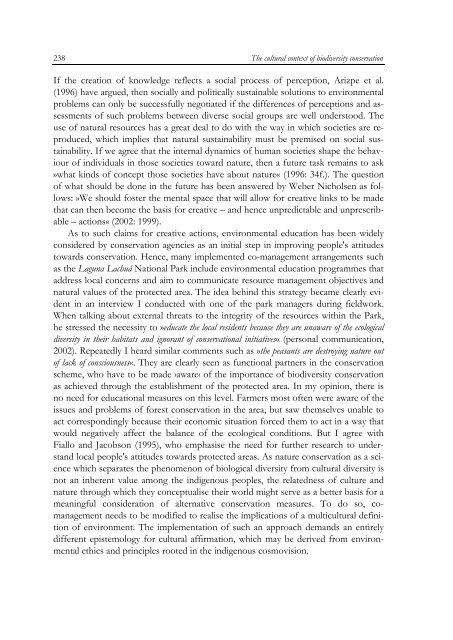The cultural context of biodiversity conservation - Oapen
The cultural context of biodiversity conservation - Oapen
The cultural context of biodiversity conservation - Oapen
You also want an ePaper? Increase the reach of your titles
YUMPU automatically turns print PDFs into web optimized ePapers that Google loves.
238<br />
<strong>The</strong> <strong>cultural</strong> <strong>context</strong> <strong>of</strong> <strong>biodiversity</strong> <strong>conservation</strong><br />
If the creation <strong>of</strong> knowledge reflects a social process <strong>of</strong> perception, Arizpe et al.<br />
(1996) have argued, then socially and politically sustainable solutions to environmental<br />
problems can only be successfully negotiated if the differences <strong>of</strong> perceptions and assessments<br />
<strong>of</strong> such problems between diverse social groups are well understood. <strong>The</strong><br />
use <strong>of</strong> natural resources has a great deal to do with the way in which societies are reproduced,<br />
which implies that natural sustainability must be premised on social sustainability.<br />
If we agree that the internal dynamics <strong>of</strong> human societies shape the behaviour<br />
<strong>of</strong> individuals in those societies toward nature, then a future task remains to ask<br />
»what kinds <strong>of</strong> concept those societies have about nature« (1996: 34f.). <strong>The</strong> question<br />
<strong>of</strong> what should be done in the future has been answered by Weber Nicholsen as follows:<br />
»We should foster the mental space that will allow for creative links to be made<br />
that can then become the basis for creative – and hence unpredictable and unprescribable<br />
– actions« (2002: 1999).<br />
As to such claims for creative actions, environmental education has been widely<br />
considered by <strong>conservation</strong> agencies as an initial step in improving people's attitudes<br />
towards <strong>conservation</strong>. Hence, many implemented co-management arrangements such<br />
as the Laguna Lachuá National Park include environmental education programmes that<br />
address local concerns and aim to communicate resource management objectives and<br />
natural values <strong>of</strong> the protected area. <strong>The</strong> idea behind this strategy became clearly evident<br />
in an interview I conducted with one <strong>of</strong> the park managers during fieldwork.<br />
When talking about external threats to the integrity <strong>of</strong> the resources within the Park,<br />
he stressed the necessity to »educate the local residents because they are unaware <strong>of</strong> the ecological<br />
diversity in their habitats and ignorant <strong>of</strong> <strong>conservation</strong>al initiatives« (personal communication,<br />
2002). Repeatedly I heard similar comments such as »the peasants are destroying nature out<br />
<strong>of</strong> lack <strong>of</strong> consciousness«. <strong>The</strong>y are clearly seen as functional partners in the <strong>conservation</strong><br />
scheme, who have to be made ›aware‹ <strong>of</strong> the importance <strong>of</strong> <strong>biodiversity</strong> <strong>conservation</strong><br />
as achieved through the establishment <strong>of</strong> the protected area. In my opinion, there is<br />
no need for educational measures on this level. Farmers most <strong>of</strong>ten were aware <strong>of</strong> the<br />
issues and problems <strong>of</strong> forest <strong>conservation</strong> in the area, but saw themselves unable to<br />
act correspondingly because their economic situation forced them to act in a way that<br />
would negatively affect the balance <strong>of</strong> the ecological conditions. But I agree with<br />
Fiallo and Jacobson (1995), who emphasise the need for further research to understand<br />
local people's attitudes towards protected areas. As nature <strong>conservation</strong> as a science<br />
which separates the phenomenon <strong>of</strong> biological diversity from <strong>cultural</strong> diversity is<br />
not an inherent value among the indigenous peoples, the relatedness <strong>of</strong> culture and<br />
nature through which they conceptualise their world might serve as a better basis for a<br />
meaningful consideration <strong>of</strong> alternative <strong>conservation</strong> measures. To do so, comanagement<br />
needs to be modified to realise the implications <strong>of</strong> a multi<strong>cultural</strong> definition<br />
<strong>of</strong> environment. <strong>The</strong> implementation <strong>of</strong> such an approach demands an entirely<br />
different epistemology for <strong>cultural</strong> affirmation, which may be derived from environmental<br />
ethics and principles rooted in the indigenous cosmovision.

















